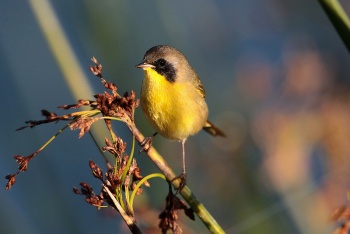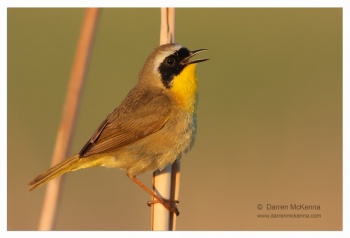
Photo © by digishooter
Bolsa Chica Ecological Reserve, California, USA, 1 March 2009
- Geothlypis trichas
Identification
- 11-15 cm (5 ins)
- Upper parts Olive-brown
- Throat and upper breast bright yellow
- Male has bold black mask, bordered above with white.
- Females and young males lack the face mask, but retain yellow throat. Can be confused with Yellow Warbler: structure (especially bill shape), and often browner colouration help distinguish from this species. Yellow Warbler can show more marked yellow flight feather edgings but this isn't always the case.
Distribution
Breeding Alaska, Ontario, and Newfoundland south throughout United States.
Winters in southern states and in tropics.
Accidental vagrant to Great Britain (5 records).
The bird is the northernmost member of a group of yellowthroat species that occurs as far south as Argentina.
Taxonomy
Subspecies
There are 13 or 14 subspeces1:
- G. t. arizela - breeds coastal pacific from southeastern Alaska south to central coastal California
- G. t. campicola - breeds from British Columbia east to western Ontario south to Idaho east to Nebraska
- G. t. chapalensis - breeds in northwest Mexico
- G. t. chryseola - breeds se. Arizona to south New Mexico, west Texas and north west Mexico
- G. t. ignota - breeds in the Gulf Coast from eastern Louisiana east to whole state of Florida
- G. t. insperata - breeds in southern Texas (Rio Grande Valley south of Brownsville)
- G. t. melanops - breeds in central Mexico
- G. t. modesta - breeds in western Mexico
- G. t. occidentalis - breeds from central Washington south to Nevada east to western Kansas and New Mexico
- G. t. scirpicola - breeds in southern California, northern Baja California, southern Nevada, and western Arizona
- G. t. sinuosa - breeds in San Francisco bay region
- G. t. trichas - breeds throughout the east from western Ontario south to North Carolina and eastern Texas
- G. t. typhicolai - breeds from central eastern Mississippi east to coastal Carolinas and Georgia
- G. t. yukonicola - breeds in Yukon Territory and northern British Columbia
yukonicola is not generally recognised.
Hybridization occurred once with Mourning Warbler.
Habitat

Photo © by Aaron Maizlish
Lake Merced, San Francisco, California, 2 November 2012
Moist thickets and grassy marshes, almost anywhere where it is damp or with water.
Behaviour
Rather wren-like.
Breeding
Three to five white eggs, with brown and black spots, in a loose mass of grass, sedge, and bark, lined with rootlets, hair, and fine grass, and concealed on or near the ground in a dense clump of weeds or grass, in a marshy area.
At the height of the breeding season, the males perform an attractive flight display, mounting into the air while uttering a jumble of high-pitched notes, then bouncing back into the grass while giving the usual song. To foil predators, parents drop down into the thick of the grasses or weeds, secretly approach their well-hidden nest, deliver the food, and depart by another route.
Vocalisation
Song: Loud, fast witchity-witchity-witchity-witchity-wit or which-is-it, which-is-it, which-is-it.
Call: a sharp chip.
Song:
Recording © by NJLarsen, Carolina Sandhills NWR, South Carolina, USA, 29 April 2023. Note by the recorder: There is a background buzz on the recording sounding similar to a Common Nighthawk, but I am pretty convinced it is an insect making that sound.
References
- Dunn, Jon; Garrett, Kimball. 1997. A Field Guide to Warblers of North America. Boston: Houghton Mifflin Company. ISBN 9780395783214
- Clements, J. F., T. S. Schulenberg, M. J. Iliff, S. M. Billerman, T. A. Fredericks, B. L. Sullivan, and C. L. Wood. 2019. The eBird/Clements Checklist of Birds of the World: v2019. Downloaded from http://www.birds.cornell.edu/clementschecklist/download/
- Guzy, M. J. and G. Ritchison (2020). Common Yellowthroat (Geothlypis trichas), version 1.0. In Birds of the World (P. G. Rodewald, Editor). Cornell Lab of Ornithology, Ithaca, NY, USA. https://doi.org/10.2173/bow.comyel.01
- Cornell Lab of Ornithology. 2019. All About Birds. Cornell Lab of Ornithology, Ithaca, New York. https://www.allaboutbirds.org Accessed on 9 May 2020
Recommended Citation
- BirdForum Opus contributors. (2025) Common Yellowthroat. In: BirdForum, the forum for wild birds and birding. Retrieved 9 May 2025 from https://www.birdforum.net/opus/Common_Yellowthroat
External Links
Search the Gallery using the scientific name:
Search the Gallery using the common name:
GSearch checked for 2020 platform.







